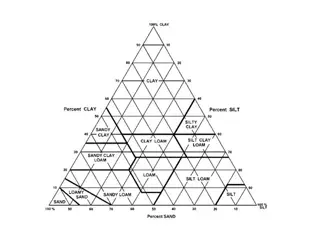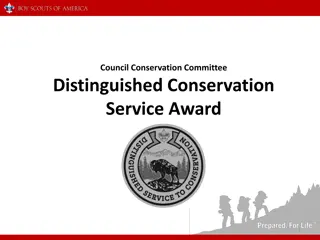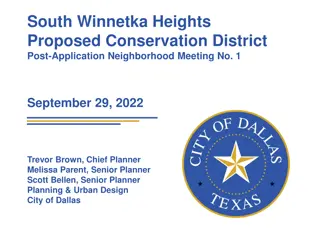Understanding Conservation Project Planning Basics
This module explores basic terminology in conservation project planning, focusing on key concepts like project, intervention, and community project. It delves into understanding the steps involved in planning for conservation projects, with a special emphasis on terminology and definitions essential for effective implementation. The content provides insights into the core elements of the planning process, offering a foundational understanding for successful community conservation initiatives.
Download Presentation

Please find below an Image/Link to download the presentation.
The content on the website is provided AS IS for your information and personal use only. It may not be sold, licensed, or shared on other websites without obtaining consent from the author. Download presentation by click this link. If you encounter any issues during the download, it is possible that the publisher has removed the file from their server.
E N D
Presentation Transcript
Module 6 - Planning community conservation interventions and projects Uganda Wildlife Authority Community Conservation Wardens Training Pack: 2018 & 2019 1
This module is part of the UWA Community Conservation Warden training package, which was designed for UWA, with support from IIED and funding from UK Aid. The package contains the following modules: 1. Introduction to Community Conservation 2. Effective Communication 3. Community Mobilisation 4. Facilitating Community Meetings 5. Undertaking Gender Assessments for Conservation 6. Planning Community Conservation Interventions and Projects 7. Conflict Management 8. Monitoring & Evaluation Reporting All modules can be found via www.iied.org/UWA-warden-training 2
Module 6: Planning a Community Conservation Intervention 1. Basic terminology in conservation interventions and projects Learning objective: Understand terminology 2. Planning Learning objective: Learn about the steps of planning for a conservation project or intervention Note: this module focuses on the core elements of the planning process: for details on budgeting, and on monitoring and evaluation, please refer to Bibby and Adler 2008 3
1. BASIC TERMINOLOGY IN CONSERVATION INTERVENTION AND PROJECT Learning objective 1: Understand basic terminology in conservation intervention and project planning 4
Concepts and definitions Project Intervention Community project Planning 5
Project A series of activities aimed at bringing about clearly specified objectives within a defined period and with a defined budget Clearly identified stakeholders and target beneficiaries Defined management and financing arrangements A monitoring and evaluation system European Commission, 2004: 8 A project is a group of interrelated activities and results with a unified purpose, together with the resources and time frame to achieve them Bibby and Alder 2003: 4 6
Intervention An intervention is a mechanism or tool for solving a problem ; interventions can constitute the different elements of a project An intervention may include educational programmes, new or stronger policies, or a promotional campaign In conservation, interventions usually focus on behavioural change ICRC 2008: 19 7
Community project Community project refers to actions planned and undertaken by a community in response to a collaborative decision to make a change or an improvement Characterised by a high degree of participation and engagement (see Module 3: Community Mobilisation) 8
Planning Planning is about informed decisions based on structured and logical thinking about the future, which resources are required, and working out how you will know whether you have achieved your objectives Planning is a means to an end, not an end in itself You need to be flexible and adjust your plan as you work Bibby and Adler 2003 9
2. PLANNING Learning objective 2: Learn about the steps of planning for a conservation project or intervention NB: the focus here is on projects but the principles apply to planning an intervention 10
Project planning Project planning is a process of structured and logical thinking, in which the overall aim is to co-ordinate decisions that will influence, direct and control the future and help to achieve the project objectives - Bibby and Adler 2003 11
Brainstorm: why plan? Consider the following scenarios An organisation contacts you asking for US$100,000 to conserve a forest that is a wildlife corridor for elephants from your park to another protected area An community conservation warden wants US$5,000 from HQ to do important community work to save a threatened bird species around a protected area Would you give them the money? How would you make your decision? Bibby and Adler 2003 12
Brainstorm: why plan? You will need more information before you decide to allocate any amount of money, large or small What do you need to know to make your decision? How important the forest area or threatened bird is What kind of problems or conflicts there are at the sites What they want to spend the money on Whether the organisation or community conservation warden is capable of doing the job Whether the project proposed requires a smaller or bigger budget than the one asked for Bibby and Adler 2003 13
Brainstorm: why plan? You would be concerned if you found out that the money was going to be used for conserving a site already designated for logging and where the applicant for funds had no ability to influence this Equally as worrying would be finding out that local people are opposed to the project because it would fence off an important grazing area Planning helps you to identify possible problems and obstacles in advance! There are certain questions you can ask and tools you can use to assist you in planning effectively Bibby and Adler 2003 14
Planning: key elements Whatever your approach, there are some key elements to project planning. Think of planning as a structured way to answer fundamental questions of any project: 1. Why do we need a project? (problem and stakeholder analysis) 2. What are we trying to achieve? (goals and objectives) 3. How are we going to achieve our objectives? (project strategy) 4. What do we need to achieve our objectives? (inputs and resources) 5. How will we know when we have reached our goal(s)? (indicators, monitoring and evaluation) 6. Who is doing what? (roles and responsibilities) Bibby and Adler 2003 15
Principles of a good project plan 1. A clear statement of the overall objective 2. A set of realistic sub-goals focusing on the overall goal 3. A set of indicators for monitoring and evaluating progress towards objective(s) 4. Use of best information and lessons learnt from past projects 5. Involvement of stakeholders and beneficiaries 6. Flexibility of approach 7. Comprehensive grasp of all aspects of the issue at hand 8. Identification of key external and internal influencing factors 9. Shared understanding of the plan from all those involved Bibby and Adler 2003 16
Two approaches to planning: Top down Bottom up or participatory Plans are formulated by management and then passed down for implementation Plans are produced involving active participation of stakeholders Often used for large-scale development plans or to define the strategic orientation of organisations Generally used for specific community projects where the participation of local people is crucial for project success Based on a number of specialists who agree priorities (such as globally threatened species) and set high level objectives and targets In practice, your approach will probably be somewhere between the two extremes. For more detail on the advantages and disadvantages of these approaches, see Adler and Bibby 2008, p35 17
Group work: principles and skills in project planning Sharing stories: building a wall of success (15 minutes) In groups: 1. A participant describes a successful project he/she has implemented with community members, including information about their role in the process, and lessons learnt 2. Another participant describes a project that did not work, including information on their role in the process, and lessons learnt 18
Planning Step 1: Ideas This is about deciding what needs to be done, based on ideas of a desired situation E.g. there is illegal cutting of trees in Kibera sector of the park. You want to control or stop this activity Ideas of a desired situation You ll have good results if there is regulated access to trees inside the park You ll have even better results if people have access to trees outside the park You ll have even better results if the two activities are combined 19
Planning Step 1: Ideas Thinking about your desired situation What behaviour needs to change? Whose behaviour needs to change? How can people be helped or allowed to change their behaviour? What changes need to happen as a direct result of the project(s)? In this case, little or no cutting of trees in the park Participatory methods might be useful to identify the issues and how local people define the problem e.g. focus groups or other workshop activities 20
Planning Step 2: Stakeholder analysis We need to know the stakeholders because these are people who can influence the success of your project, and who can inform it. Think especially about the following: Targets of change people whose behaviour you are trying to change may or may not be the same people who will benefit from the project Agents of change people who can make change occur Could be leaders, or community role models 21
Planning Step 2: Stakeholder analysis Stakeholder analysis can involve a combination of CCW knowledge and participatory approaches for example, the CCWs can brainstorm the most obvious stakeholders, then use interviews/focus groups/surveys to uncover the less obvious stakeholders. It is important not to forget any vulnerable groups (Schneider 2016) Stakeholder identification is an iterative process; see Module 7: Conflict Management for more details on stakeholder analysis tools, and Module 5: Undertaking Gender Assessments for Conservation for a reminder of why gender analysis is important! 22
Planning Step 2: Stakeholder analysis Who are the stakeholders in the case of illegal cutting of trees in the park? Charcoal burners Pitsawyers People constructing homes Women collecting firewood People trading firewood Local politicians and leaders 23
Planning Step 3: Problem analysis In this step the objective is to understand the situation the project intends to address. There are various methods that can be used to help you understand the problem at hand: Community assessment and problem identification (participatory methods) Problem analysis Problem tree See Module 7: Conflict Management for more details on the above problem analysis tools 24
Planning Step 3: Problem analysis How to think about your problem: Ensure that you identify real, existing problems Don t become preoccupied with defining a core problem from the very beginning; this will become clearer through later discussion When defining a problem try not to do it in terms of lack ie a problem is not a lack of a solution, but rather an existing unwanted situation (Bibby and Alder 2008) 25
Planning Step 3: Problem analysis Writing a clear and concise problem statement is necessary before moving onto Step 4 it will guide all further steps! Elements of a good problem statement: Description, quantitative and qualitative, of the problem Stakeholder impacts, described quantitatively and qualitatively (who and how many) Concise explanation of causes and impacts of the problem 26
Planning Step 3: Problem analysis Example of a problem statement Clearance of woodlands for firewood and cash-crop farming has left the valley with only 10% of its original forest cover. Fourteen restricted range birds occur in these forests of which three are globally threatened. Continuing clearance is increasing the isolation of surviving forest fragments, which may render populations of the least dispersive species non-viable. Some 40 families live on smallholdings in the valley and make their income from cash-crops. A thriving eco-tourism business on the lower slopes rarely brings visitors to the forest because the area is difficult to access from the nearest tourist accommodation 50 kilometres away. Local people may have a very low per capita income and continued forest clearance provides the only option they currently have available to supplement this. The total loss of these forests would be a major loss to biodiversity, not only in terms of birds, but probably other taxa too. Bibby and Adler 2003 27
Group activity: brainstorm Example of illegal tree cutting in Kibira National Park What could be another unwanted situation in Bugote sector of the park? Reduced sighting of Crowned Cranes in Bugote sector of the park near Bushura parish because of intensive tree cutting....... 28
Planning Step 4: Stakeholder involvement Involve stakeholders of the project and potential clients depending on what the issues/problems are This is the point to make sure all your identified stakeholders are involved, engaged, and able to give their input Don t assume you already know what they want use tools such as PINs analysis see Module 7: Conflict Management Encourage people to take ownership see Module 3: Community Mobilisation 29
Planning Step 4: Stakeholder involvement How to involve stakeholders Informal personal contact Interviews Focus groups 30
Planning Step 5: Set goals and objectives Objectives are statements of how you want the world to look when you have fixed a particular problem , Adler and Bibby 2008; 50 Answer the following questions as concretely as possible: 1. What should the project accomplish? GOAL 2. What will success look like? OUTCOMES 3. How will you explain to other people that the project has worked? OUTPUTS 4. What are the benchmarks you will use to show you are moving in the right direction? INDICATORS 31
Planning Step 5: Set goals and objectives Hierarchy of project objectives: One overall project goal One overall project purpose Approximately 4-10 results Approximately 4-10 activities per result You may wish to use a log-frame (logical framework) to plan your project s goal, purpose, results and corresponding activities. For more details on using log-frames, refer to Adler and Bibby 2008, Section 3.6 32
Planning Step 5: Set goals and objectives SMART objectives Each objective needs to be a single sentence statement describing a desired future state. Use SMART to keep you focused. SMART objectives should be: o Specific o Measurable o Achievable o Realistic o Timebound Bibby and Adler 2003 33
Planning Step 6: Identify the specific project This is where you look at your objectives as per Step 5, and work out what should be done to achieve them Note: You can use an evidence-based model for planning your project. This means using data on outcomes of previous similar project to inform your objectives, helping you to think about what may and may not work in your context (see Baker et al 2015) 34
Planning Step 7: Risk Assessment and mitigation Identify barriers and resistance you might come up against What barriers and resistance might you face? How can they be overcome? Be prepared for whatever may come your way! For example: Pitsawyers and timber dealers may resist the project What are suitable tree species for planting (termites, food security, acceptance) Appropriate income generating projects; e.g. if community is predominantly Muslim, you may not promote piggery projects Gender issues, land ownership, land tenure 35
Planning Step 8: Develop a strategy Taking into account your identified objectives and desired results from Step 5, your chosen project from Step 6, and your risks from Step 7, you can now develop your strategy the big idea approach that will then be broken down into specific activities Examples: Raise awareness and sensitisation of target community about the dangers of uncontrolled tree cutting from the park Provide alternative sources of income to the poor households and people directly engaged in tree cutting from the park for domestic or commercial purpose 36
Planning Step 9: Develop an action plan to implement the project This is where you identify who will do what activities, when, and with what resources to support them. What components and elements will be implemented? Who should implement what by when? What resources and support are needed? What is available? What potential barriers or resistance are expected? How will they be minimised? What individuals or organisations need to be informed? What do you need to tell them? 37
Planning Step 9: Develop an action plan to undertake the project Example Activity Objective Time Frame Responsible person Where Beneficiaries (who and number) Funding What should other partners do What should communities do Funding Source Amount 38
Planning Step 10: Implement your project If you have followed all the steps, implementation will be made easier. Consider piloting your activities; remember to budget for this! Be adaptable and flexible; as conditions change, so should your strategy! 39
TO SUM UP.... 1. Planning takes time but it is absolutely crucial 2. Follow all the steps methodically BUT remember to remain flexible and adaptable where necessary! As your situation changes, so should your plan 3. Refer to allthe previous training modules all those skills are necessary for successful project planning and implementation! 40
Dont forget! Turn to the Work Plan in your training manual and think about your key learning from today, and how you might apply it in practice! 41
Acknowledgement These modules were developed and administered by Mrs Eunice Duli and Mrs Agripinnah Namara 42
Thank you This training is part of the project: Implementing park action plans for community engagement to tackle IWT, coordinated by IIED and grant funded by the UK government s Illegal Wildlife Trade (IWT) Challenge Fund. The IWT Challenge Fund is for projects around the world tackling illegal wildlife trade and supports action in three areas, including developing sustainable livelihoods for communities affected by illegal wildlife trade. The views expressed are not necessarily the views of the UK government. 43
References Bibby C. J. and Alder, C. (eds), 2003, The Conservation Project Manual, BP Conservation Programme, Cambridge UK https://www.icrc.org/en/doc/assets/files/publications/icrc-001- 0951.pdf Baker J. et. al., (2015), Fairer, better. A guide to more effective Integrated Conservation and Development in Uganda, IIED. UK. https://pubs.iied.org/14649IIED/ Schneider et al 2016, INTRINSIC: Integrating Rights and Social Issues in Conservation (A Trainer s Guide), http://www.cambridgeconservation.org/resource/toolkits/intrinsic- integrating-rights-and-social-issues-conservation-trainers-guide 44























